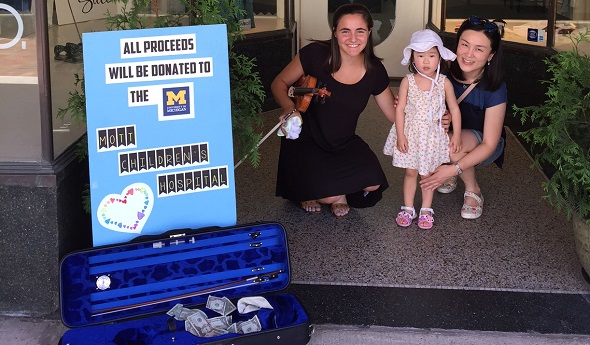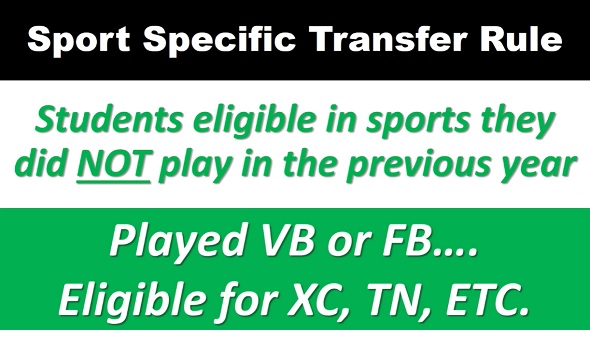
Chance to Touch Lives 'Drives' Huron's Sesi
May 25, 2017
By Geoff Kimmerly
Second Half editor
Only a few times, collecting more than 300,000 cans and bottles was as gross as it might sound.
 Of course there was some mold, and a few bags had dead mice in them. Once, a bag was filled with ants, and Katie Sesi and her family would find them crawling around their car for the next month.
Of course there was some mold, and a few bags had dead mice in them. Once, a bag was filled with ants, and Katie Sesi and her family would find them crawling around their car for the next month.
Another time, a duck bit her.
But those are just some of the funnier memories that were more than worth the opportunity for Sesi to meet and help an untold number of people, beginning when she was 6 years old – truly a life’s work so far for the Ann Arbor Huron junior.
Sesi is a recipient of an MHSAA/Lake Trust Credit Union “Community Service Award” for her work raising $40,000 over the last decade for University of Michigan’s C.S. Mott Children’s Hospital. Playing her violin at the Ann Arbor Art Fair annually beginning in elementary school, and then taking on a can drive that’s seen her canvass neighborhoods all over her city and surrounding area, Sesi has managed to raise $10,000 every two years since 2010.
She’s also met at least 50 of her donors over that decade and received in the neighborhood of 300 letters from people encouraging her work and asking how else they might help.
“Meeting new people is just a good experience. It’s really interesting to learn about other people’s lives,” Sesi said. “My favorite part was the personal interaction. When I started doing the can drives, I didn’t think I’d talk to a bunch of people and learn their life stories. But people leave me notes that say, ‘Hey, you should come talk to me.’ For me, just talking to people is really fun. The unexpected chance to meet more people has been very memorable.”
It’s also an incredible story, considering Sesi’s decision to start lending a hand as barely an elementary schooler.
She’s played the violin since she was 3, and recalled reading a newspaper article about two girls playing their violins at a similar outside event. She thought to herself, I should do the same. Her mother, Yvonne Sesi, challenged her to make it happen.
Katie then realized that being 6, she didn’t really need the money people would give her while passing by. So she began saving toward what would eventually become that first $10,000 donation.
 At 9, with her mom at the wheel, Katie started her can drives. The first netted only $9. But she didn’t give up. At times she would work neighborhoods every weekend, leaving a flier at people’s houses explaining her mission and letting them know when she’d be back to collect.
At 9, with her mom at the wheel, Katie started her can drives. The first netted only $9. But she didn’t give up. At times she would work neighborhoods every weekend, leaving a flier at people’s houses explaining her mission and letting them know when she’d be back to collect.
Soon, the car was regularly full with the front seats moved up as far as possible to make room for the overflowing supply of returnables. She estimates she’s collected cans and bottles “several hundred” times.
Sesi’s first donation to C.S. Mott went toward building “The Treehouse” indoor playground, and subsequent donations have gone toward research of childhood cancers and the hospital’s Child and Family Life center, which provides support for patients and their families during treatment.
Yvonne is a doctor, and Katie is interested in becoming a pediatric oncologist (or going into business, or perhaps both). Helping children is especially close to her heart; one of her most memorable can drive interactions came with a family that had lost a son to lymphoma who had been treated at Mott; they invited her in to meet their newborn daughter they’d adopted after his death.
She’s choosing to donate half of her $1,000 award to U-M’s Chad Tough Fund, which directs funds to childhood cancer research in honor of Chad Carr, the grandson of retired Wolverines coach Lloyd Carr who died in November 2015 at age 5 after a fight with pediatric brain cancer. She’ll donate the other half of her award to the Ann Arbor Huron girls tennis team; she’s an all-state No. 1 singles player and team captain.
A regular in some neighborhoods, where people recognize her from past drives, Sesi said she’s learned a lot about perseverance and hard work – but again, is most inspired by the many people she’s met along the way.
“I knew early on that I wanted the money to go to children with cancer because it seemed to me completely unfair that kids should be denied a carefree and fun childhood,” Sesi wrote in her application for the award. “All together, I found that people have tremendous hearts and an unlimited capacity for supporting, helping and giving to others."
The Community Service Awards are sponsored by the Michigan High School Athletic Association and Lake Trust Credit Union to recognize student-athletes' efforts to improve the lives of others in their communities. In addition to the $1,000 award, the Lake Trust Foundation is awarding an additional $500 to each honoree, to be donated to a non-profit, 501 (c)(3) organization of the awardee’s choice.
PHOTOS: (Top) Katie Sesi, next to her violin case, has played to raise money every summer since she was 6 at the Ann Arbor Art Fair. (Middle) Sesi has received hundreds of notes like this one thanking her for her efforts. (Photos courtesy of Katie Sesi.)
2017 Community Service Awards
Sunday: Colon "Yard Squad" - Read
Monday: Bailey Brown, Brighton - Read
Tuesday: Justice Ottinger, Newaygo - Read

Brush Up on the New Transfer Rule
July 18, 2019
By Rob Kaminski
MHSAA benchmarks editor
Eligibility under the new “sport-specific” transfer rule begins this coming fall after circulating extensively for nearly one school year.
Unless one of the stated 15 exceptions is met, participation during the 2018-19 school year determines eligibility for 2019-20.
The new rule adopted by the Representative Council at its May 2018 meeting has found support among most audiences. A transfer student’s eligibility in 2019-20 is based upon that student’s participation from this past school year (2018-19). It will be paramount for administrators and coaches to have awareness of the sports a transfer student participated in during the previous school year.
The long-standing 15 Exceptions to immediate eligibility, such as a full and complete residential change or a student moving between divorced parents by completing of an Educational Transfer Form, did not change.
One might call the rule on the way out “The Fourth-Friday Transfer Rule.” Under this old rule, when a student enrolled at the new school determined his or her eligibility. Under the new Sport Specific Transfer rule, what a student played in the previous season determines eligibility.
The Council passed a more lenient rule on the one hand and more restrictive on the other. The more lenient aspect is a change that finds a transfer student ELIGIBLE in any sport in which he or she did not participate in a game or a scrimmage in the previous school year.
The more restrictive portion tends to discourage students who change schools for sports reasons. A transfer student who did play a sport in the previous season – and who does not meet one of the 15 Exceptions – is NOT ELIGIBLE in that sport for the next season. If a student changes schools in mid-season, the student would be ineligible for the rest of that season in that sport and the next season for that sport.
Participation under this and other rules means playing in an interscholastic game or scrimmage after starting the 9th grade at any high school. It does not mean practice, but entering an interscholastic game, meet or scrimmage in any way. It also may involve more than one sport, so a three-sport athlete who does not have a residential change and transfers would be ineligible in those sports during the next school year – but eligible for any other sport. It also means a student cut from a team – one who never entered a scrimmage or game – may transfer and play without delay for that new school’s team. It may also mean that a student who meets one of the stated exceptions such as a residential change but enrolls in a school other than her or his school of residence, would have eligibility in sports not played in the previous year.
The new rule will tend to discourage students from changing schools for sports because they would be ineligible in any sport they have played in school the previous season for that sport. It will increase participation for some students who were otherwise not eligible under the current rule.
It is always best to contact school athletic directors who can connect with the MHSAA to verify eligibility prior to enrollment.
If the student’s new school requests in writing, the MHSAA Executive Committee may approve a waiver that reduces the period of ineligibility to 90 scheduled school days at the new school if the change of schools was for compelling reasons demonstrated with outside documentation having nothing to do with sports, curriculum, finances, and school demographics. The Executives Committee also has authority to approve immediate eligibility.

